Archive for the 'Corn' Category
Our multi-grafted Japanese plum tree is full of plums right now. It’s a very small tree, about 5 feet tall and 4 feet wide. But it has over 100 plums on it. It has the most densely packed fruit of any fruit tree we have. It would benefit from thinning, because the branches can break under the weight of the fruit, but I didn’t bother to thin this year, because the fruit set was not as heavy as last year. The main grafts are the varieties Elephant heart and Laroda, which is the dark purple fruit in the picture below.
The tree also has a graft of Nubiana, which is very small and doesn’t grow much, and Beauty. Most of the Beauty graft broke off two years ago under the weight of a heavy load of fruit. I cut off the remaining branches of Beauty, because I didn’t care for its flavor. The Elephant Heart and Laroda grafts are not self-fruitful, but both have managed to set a lot of fruit two seasons in a row without pollen from Beauty. Pollen from our pluot tree and a neighbor’s plum have probably helped. The Beauty graft was huge and on the verge of taking over the tree. The Elephant Heart and Laroda grafts have grown a lot since Beauty has been gone.
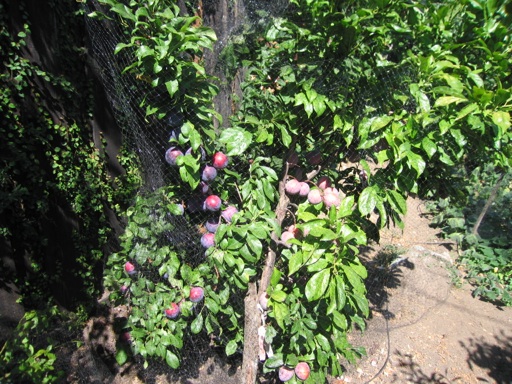
I really enjoy growing sugar pie pumpkins and butternut squash. I have found that they are both easy to grow from seed as long as they get regular water. I planted several groups of seeds last March. The vines are very long now and have set many fruits, even though I haven’t fertilized them. The vines can take up a lot of space, which is why I planted the seeds where the vines can grow in between our fruit trees. I planted them directly in the ground, not in our raised beds, because the vines would just grow out of the beds and across our paths between the beds. Some of the pumpkins have even grown roots directly from the vines into the ground.
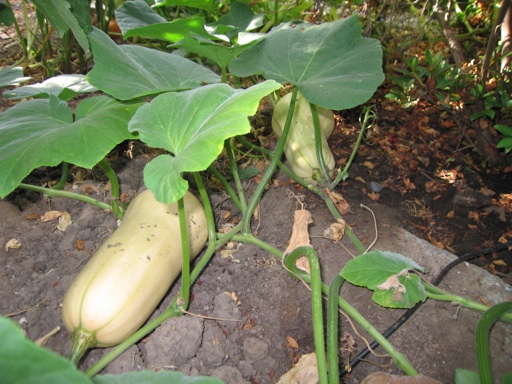
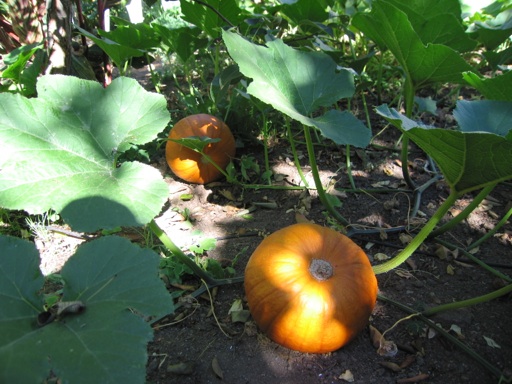
We are also growing Siam Queen (Thai) basil this year. I planted the seeds in pots in our mini-greenhouse in April and transplanted the seedlings into one of our raised beds in May. They only grow in warm weather, and it can get cold in April here. The plants grew slowly at first, but they are now starting to grow more rapidly. Their leaves have a strong scent that is similar to licorice, and their flowers are an attractive purple color. Also, they don’t seem to attract insects.
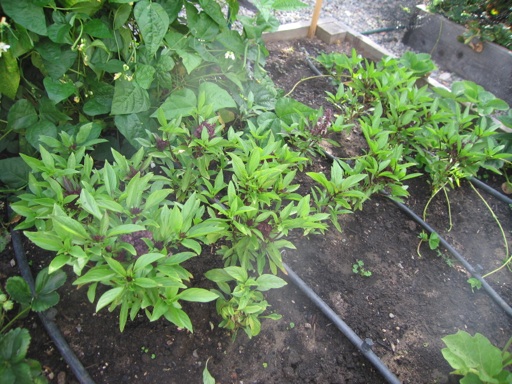
Our purple Dahlias have been full of flowers for several weeks. We are also growing them in raised beds where they get plenty of water and rich composted soil. Unfortunately, they are already getting mildew on their leaves, which happens every year around this time.
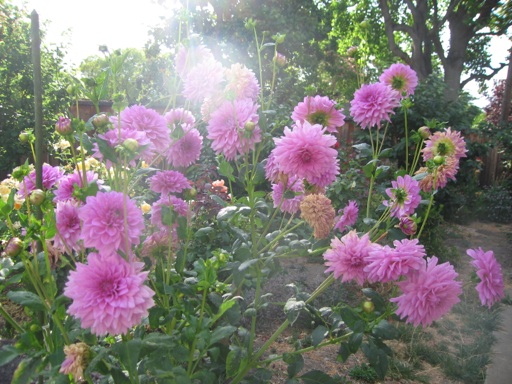
I planted corn seeds in mid-March this year, which is the earliest I have ever planted them. We almost never get frost here after March 1. I planted the peaches and cream variety, and ended up with about 18 plants. I always plant at least 15 corn seeds in a planting to ensure proper pollination. I started harvesting corn ears the first week of this month. They were very tasty.
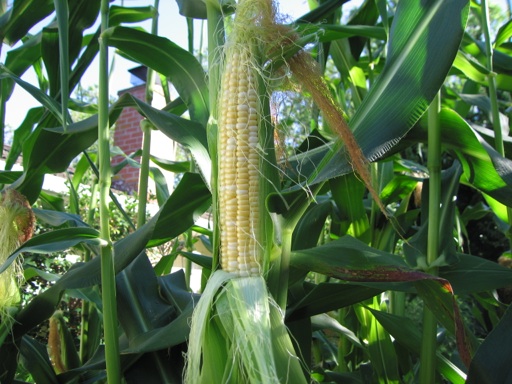
I harvested some of the last ears today. Several of the stalks had two ears, and a few stalks grew outshoots that themselves grew an additional ear of corn. I have more corn in another bed that I planted in June. They should be ready to harvest in October.
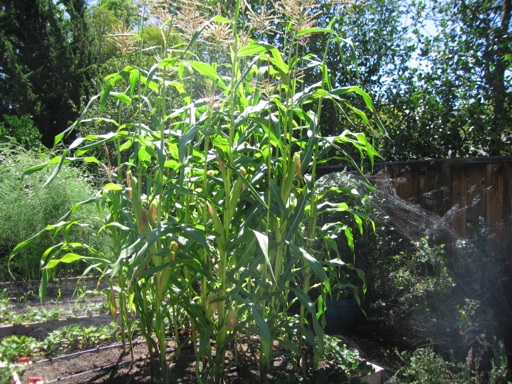
I planted Albion strawberries in pots with potting soil in May. I had not grown this variety previously. I have been picking strawberries from the Albion plants for over a month now, and they have exceeded my expectations. They have been continuously producing very sweet and large berries. They are much sweeter than Chandler, which are on the tart side in our yard. I think I will be planting more Albion strawberries in the future. So far the Albion plants have not produced many runners, unlike our Sequoia strawberries, which are prolifically producing runners right now.
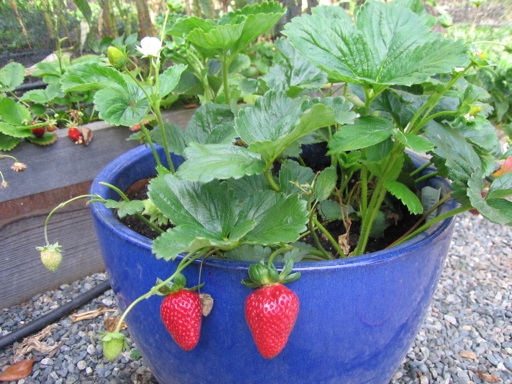
July 26 2014 | Basil and Corn and Dahlias and Plums and Pumpkin and Squash and Strawberries | Comments Off on Mid-summer post
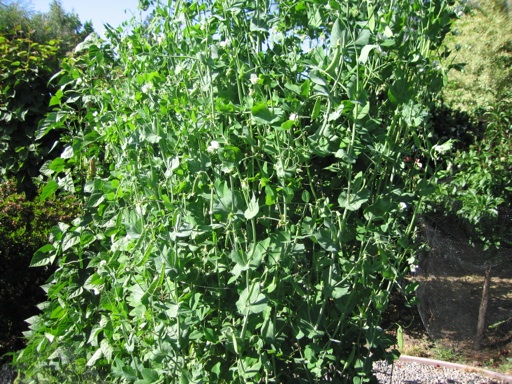
On March 1st of this year, I planted sugar snap pea seeds in one of our raised beds next to a wire trellis. All of the seeds sprouted within a week or two and grew rapidly after that. The pea vines are now over 6 feet tall (taller than the trellis) and are still growing. There are so many vines (I planted too many seeds) that wind blew them forward off the trellis a few weeks ago. I tied them back onto the trellis with string. I planted three rows of seeds at about a 3 inch spacing. Next time, I will plant only two rows of seeds spaced farther apart.
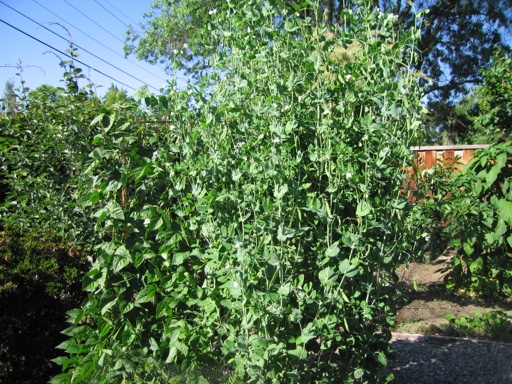
I am growing peas on the same trellis as blue lake green beans, which I have been growing for years. When I have planted green beans along the entire 6 foot long trellis in the past, the plants produced way too many beans to eat. So this year I planted half as many beans and planted peas next to the beans. The peas are out growing the beans and starting to crowd them.
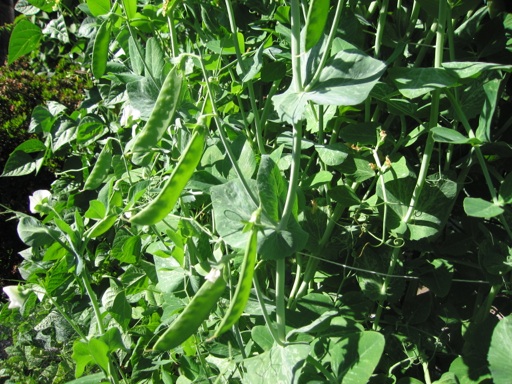
Our peas are now full of pods. I just began picking them last week. This is the first time I have grown peas, and I am wondering why I didn’t before. They are easy to grow, produce lots of sweet edible pea pods early in the growing season, and are good sources of vitamins A and K and especially vitamin C.
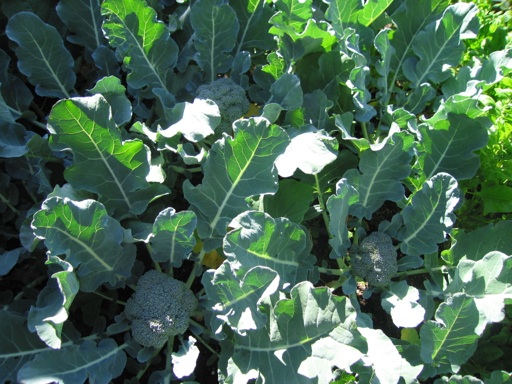
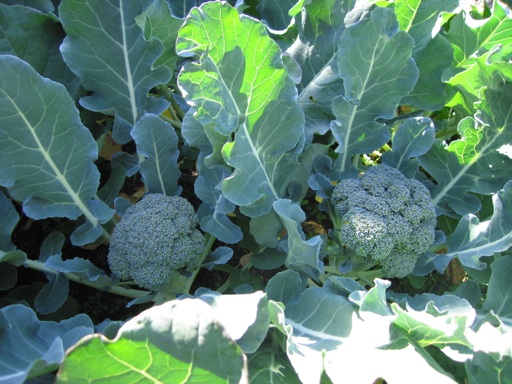
Our broccoli plants are large this year. I grew them by seed rather than buying nursery transplants, as I mentioned in a previous post. I have watered them regularly and applied water soluble fertilizer to them about once a week, which seems to have made a difference. Although right now, the plants are growing together and crowding each other out, which is probably limiting the size of the plants and the crowns. Next time, I may space them farther apart. 12 inches apart is not quite enough for maximum growth. Planting of broccoli seeds at just the right time is critical to getting large crowns. I think I got the timing right. Although, we’ve had two heat waves this month into the low 90s F, which is not ideal for broccoli growth. Our broccoli plants are forming crowns now. I just harvested the first crown today. These crowns in the lower photo look nearly ready to cut.
I also covered our broccoli plants with two layers of bird netting which helped to keep the snails away (they get stuck in it) and these white moths that want to lay larvae (worms) on the broccoli. The moths also can’t get through the netting.
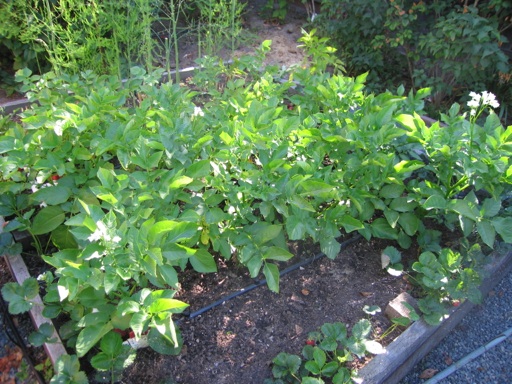
I have had mixed results with potatoes this year. I planted russet and yukon gold potatoes in Feb. and March. I have been planting potatoes in the same raised bed for years. Those potato plants (above photo) have not grown nearly as much as the potato plants that are growing in a different raised bed (below photo with corn in the back) where I had never planted potatoes until this year. It seems to be an example of the importance of rotating crops from year to year.
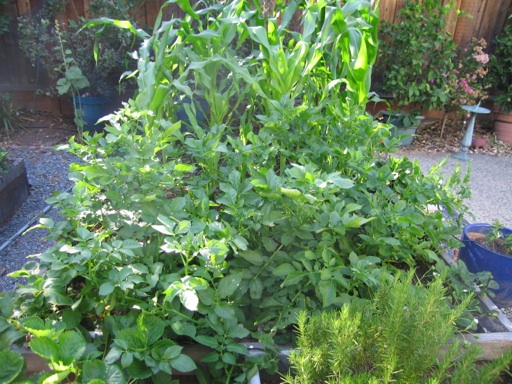
I sowed the corn seeds in mid-March, which is the earliest I have ever planted it. I sowed Peaches and Cream corn seeds, which is my favorite variety for taste. The seeds sprouted and grew about as quickly as in past years when I had always sowed the seeds in April. I am expecting to harvest corn by July 1, and then rip out these plants for a second planting of corn seeds to be harvested in late October. Home grown corn is so good, one harvest a year just isn’t enough!
May 21 2014 | Broccoli and Corn and Peas and Potatoes | Comments Off on Cool Season Crops
I harvested our first corn ears of the 2013 season today. The kernels on the ears were fully formed, although some of the kernels were too plump from being left on the stalk a few days too long. Here is a photo of them:
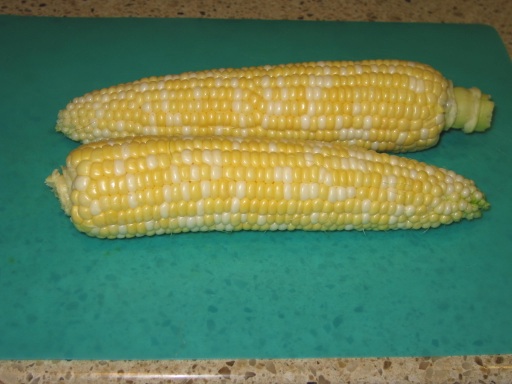
One of our corn stalks is a mutant. It has 3 corn ears on it, as seen in the next photo, which is the most I have ever seen on a single stalk. This stalk even grew suckers that also appear to be generating their own ears of corn. Typically, each stalk only produces one or two ears at the most.
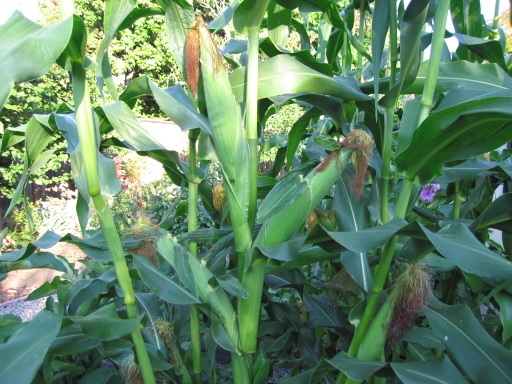
Here are more photos of the same corn patch. Many of the stalks have one or two large plump ears already. I planted these corns by seed in early April and have given them little extra care or fertilizer since then other than regular watering with an automatic micro-spary system. I planted the seeds very close together about 12 inches apart in three rows. Most of the stalks have grown to their full height, but a few of the stalks that sprouted later got crowded by the others and did not reach their full heigth. The stunted stalks tend to produce small ears or none at all.
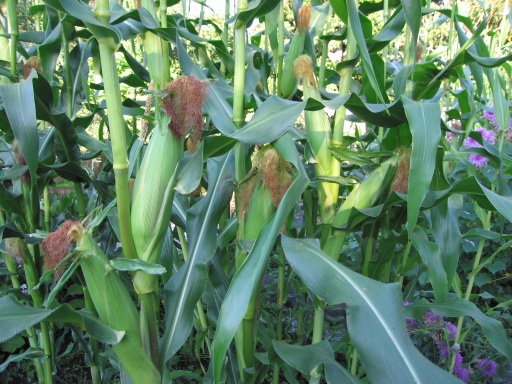
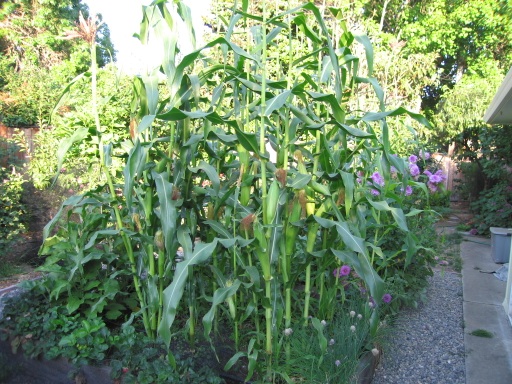
July 23 2013 | Corn | Comments Off on Mutant Corn
Last March around the first of spring, I planted blue lake pole bean seeds and light and dark green zucchini seeds directly into one of our raised beds. I stared harvesting green beans and zucchinis in late May, and they have been producing prolificly since then. This year is the earliest harvest I’ve ever had for beans and zucchini. In the past, my green beans and zucchini didn’t mature until mid-June, and I have always planted them at the same time around the first day of spring. This year’s warmer weather was likely the cause.
Below is a photo of one of my raised beds that has pole beans growing on a wire support in the back, tomatoes in the middle in square cages, zucchini up front, and strawberries growing around the edge. This is the same bed shown in my Apr. 20 post. The plants are close together, which helps to prevent weed growth.
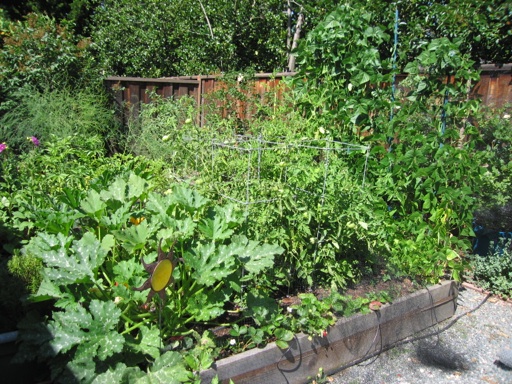
This is a close up photo of one group of my zucchinis:
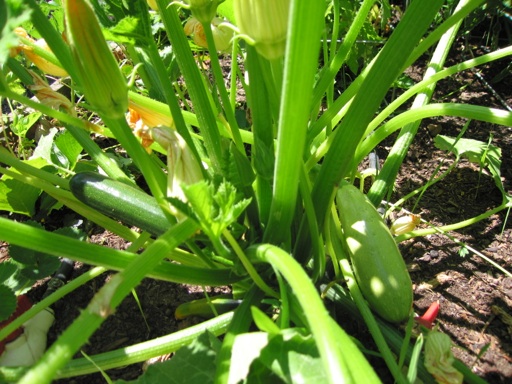
My corn plants are also precocious this year. I planted corn by seed on Apr. 8 directly into another raised bed. The corn seeds took 2 weeks to sprout, but it has been growing rapidly since then. They already are pushing out the tassels.
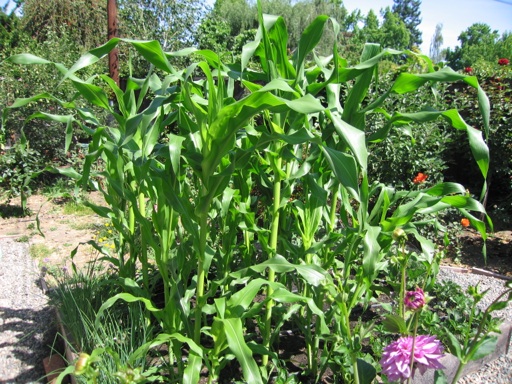
I am experimenting with growing some new edible plants this year. Peanuts are one of the new plants I am growing this year. Peanuts are supposed to thrive in warm summers. I’m not sure it will be warm enough for them here, but I think that it will be fun to try at least once. I purchased peanut seeds through an online mail order website. I planted the peanut seeds in late April. The seedlings look like little pea plants. They are already generating small yellow sweet pea-like flowers. The photo below shows what they looked like earlier today.
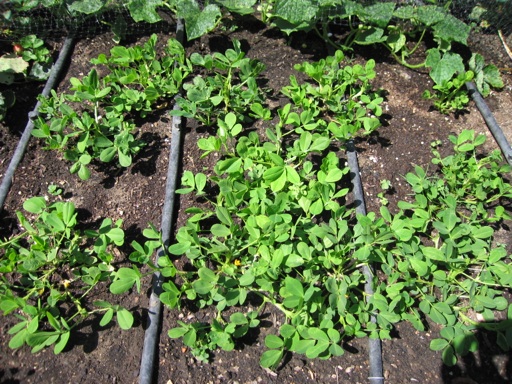
I am also growing spaghetti squash, butternut squash, and sugar pie pumpkins this year for the first time. I planted all of these by seed. I planted the spaghetti squash and pumpkin seeds in late March outdoors in small pots and then transplanted them into the ground after they had sprouted. I decided not to plant them in our raised beds, because their vines grow so long that they would grow out of the beds and along the paths around the beds, which would force me to constantly step over the vines.
Our natural soil here is clay. Our neighbors grew pumpkins successfully in their clay soil last year, which inspired me to try them this year. The spaghetti squash and pumpkin vines are already several feet long and growing rapidly. The photo below shows two spaghetti squash vines with two spaghetti squash on them.
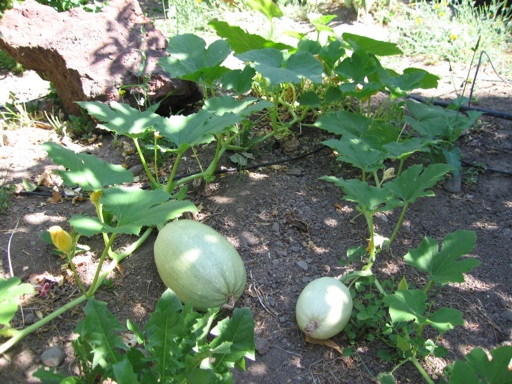
I am growing sugar pie pumpkins rather than jack-o-lantern pumpkins. I want to use pumpkins in cooking, and sugar pie pumpkins are bred for this purpose. Pumpkins are supposed to thrive in climates with relatively mild and dry summers, so they should grow reasonably well here. This is a photo of one of my pumpkin vines with a pumpkin on it:
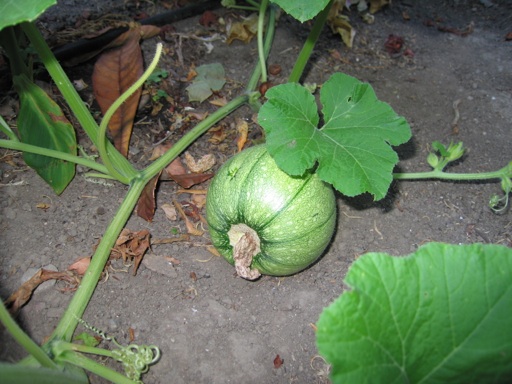
June 15 2013 | Beans and Corn and Peanuts and Pumpkin and Squash and Zucchini | Comments Off on Vegetable Assortment
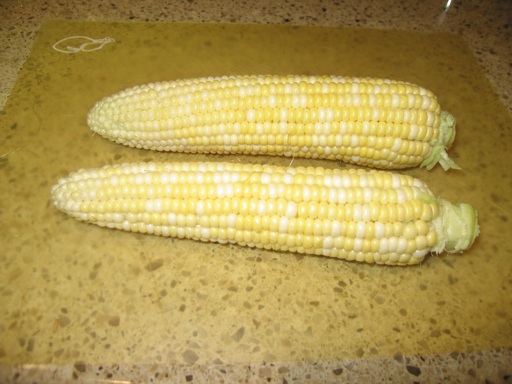
My partner and I ate corn on the cob from our vegetable garden for dinner tonight for the third night in a row. I harvested the corn just before dinner, shucked it, and then put it right into boiling water, so it didn’t have any time to lose flavor. We both thought they were some of the best tasting corn on the cobs we have ever eaten. They were sweet and very tender, unlike the tough and starchy ears of corn I have often bought from supermarkets.
My experience has been that the way to get the best tasting corn is to harvest it soon after the kernels have filled in and look matured (the way corn kernels are supposed to look). It helps to know when to expect your corn will be ready to harvest. I plant corn at the same time each year in late April, so that it is ready to harvest at the same time each year, starting around August 1. Also, corn tastes its best right after it has been harvested from the stalk. Corn seems to lose flavor when it is stored in the refrigerator for days after harvest.
The weather conditions also play a role in determining the sweetness of corn. Apparently, corn develops the most sweetness on sunny and relatively cool days. It’s mid-summer here, and everyday has been sunny after the morning fog burns off around 9 am. The daytime high temperatures have been mild, in the mid-70s to low 80s, for the past month.
August 03 2012 | Corn | Comments Off on Sweet and Tender Corn on the Cob
Next »

























